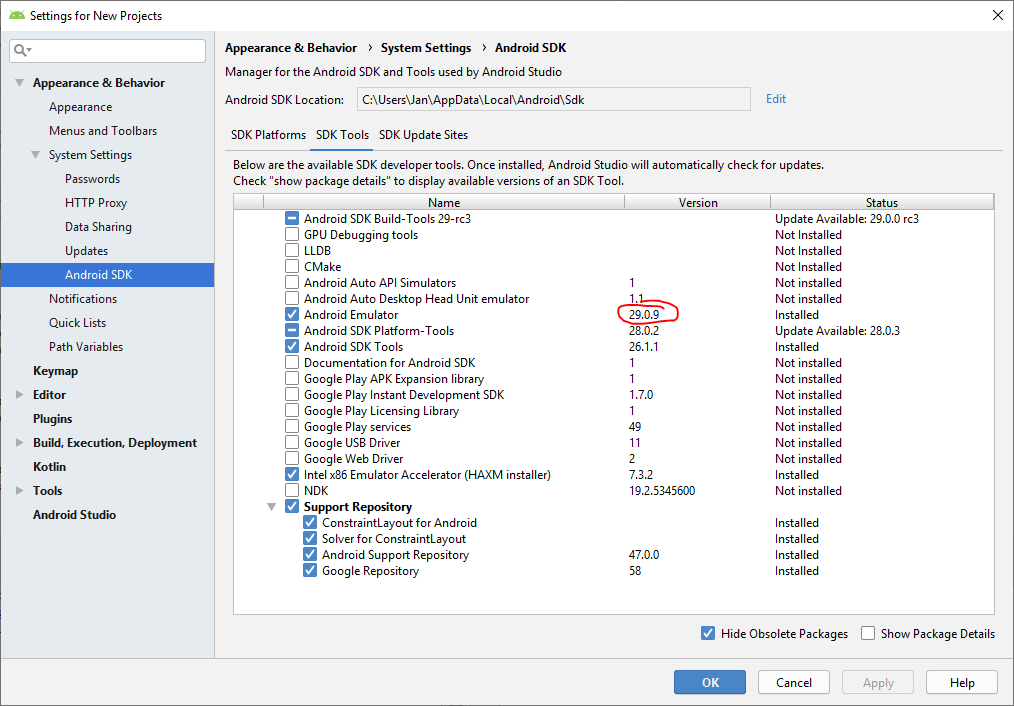


- #HOW TO OPEN EMULATOR IN ANDROID STUDIO MAC HOW TO#
- #HOW TO OPEN EMULATOR IN ANDROID STUDIO MAC INSTALL#
- #HOW TO OPEN EMULATOR IN ANDROID STUDIO MAC FULL#
- #HOW TO OPEN EMULATOR IN ANDROID STUDIO MAC CODE#
- #HOW TO OPEN EMULATOR IN ANDROID STUDIO MAC WINDOWS 7#
Check the output carefully for other software you may need to install or further tasks to perform (shown in bold text).įor example: Android toolchain - develop for Android devices This command checks your environment and displays a report of the status of your Flutter installation. Run flutter doctorįrom a console window which has the Flutter directory in the path (see above), run the following command to see if there are any platform dependencies you need to complete the setup: C:\flutter>flutter doctor Note that you will have to close and reopen any existing console windows for these changes to take effect.
#HOW TO OPEN EMULATOR IN ANDROID STUDIO MAC FULL#
If the entry does not exist, create a new user variable named Path with the full path to flutter\bin as its value. If the entry does exist, append the full path to flutter\bin using as a separator from existing values. 
Under User variables check if there is an entry called Path:.From the Start search bar, type ‘env’ and select Edit environment variables for your account.If you wish to run Flutter commands in the regular Windows console, take these steps to add Flutter to the PATHenvironment variable: Locate flutter_console.bat inside the flutter directory and start it by double-clicking.Unzip the downloaded zip in C:\flutter.
#HOW TO OPEN EMULATOR IN ANDROID STUDIO MAC WINDOWS 7#
Operating Systems: Windows 7 or later. #HOW TO OPEN EMULATOR IN ANDROID STUDIO MAC HOW TO#
How to Install Flutter on Windows? Minimum System Requirements Realize custom, beautiful, brand-driven designs, without the limitations of OEM widget sets.Benefit from a rich set of Material Design and Cupertino (iOS-flavor) widgets built using Flutter’s own framework.Fix crashes and continue debugging from where the app left off.
#HOW TO OPEN EMULATOR IN ANDROID STUDIO MAC CODE#
Experiment by changing code and reloading as your app runs (with hot reload). Do more with less code, even on a single OS, with a modern, expressive language and a declarative approach. Develop for iOS and Android from a single codebase. See this architecture diagram for a better picture of the main components. What technology is Flutter built with?įlutter is built with C, C++, Dart, and Skia (a 2D rendering engine). It also acts as a productive prototyping tool. It speeds up the development of mobile apps and reduces the cost and complexity of app production across iOS and Android.įor designers, Flutter helps deliver the original design vision, without loss of fidelity or compromises. Now, select the Path variable under your user account and click on the Edit button.For users, Flutter makes beautiful app UIs come to life.įor developers, Flutter lowers the bar to entry for building mobile apps. In the System Properties window, click on the Environment Variable button appearing at the bottom of the window.Ĥ. Open the start menu, search for Environment Variables and open it.ģ. Now, click on the address bar and copy the folder path.Ģ. Just like before, go to the Emulator folder in the Android SDK folder. Follow the below steps to add Android emulator to Windows path.ġ. That way, you don’t have to go to the SDK folder manually just to launch the virtual device. However, if you are going through this procedure frequently, then you can make your life easier by adding the Emulator folder as an environment variable to the Windows path. If you only launch AVD manager without Android Studio occasionally, then the above method is good enough. (Optional) Add Android Emulator to Windows Path If you do, the device will be turned off. You can access all the settings of the virtual device too.įinally, do not close the PowerShell or Command Prompt window while the virtual device is running. As soon as you execute the command, the AVD manager will launch the virtual device.Ħ. Don’t forget to replace with the actual device name you got from the above command.\emulator.exe -avd " "ĥ. Now, execute the below command to launch the virtual device. In my case, there is only one virtual device.\emulator.exe -list-avdsĤ. So, execute the below command and it will list all the devices with their names. To launch Android emulator, we first need to know the name of the virtual device. Note: If you are using Windows 7 or 8, you will Open Command Prompt Here option, select it.ģ.







 0 kommentar(er)
0 kommentar(er)
